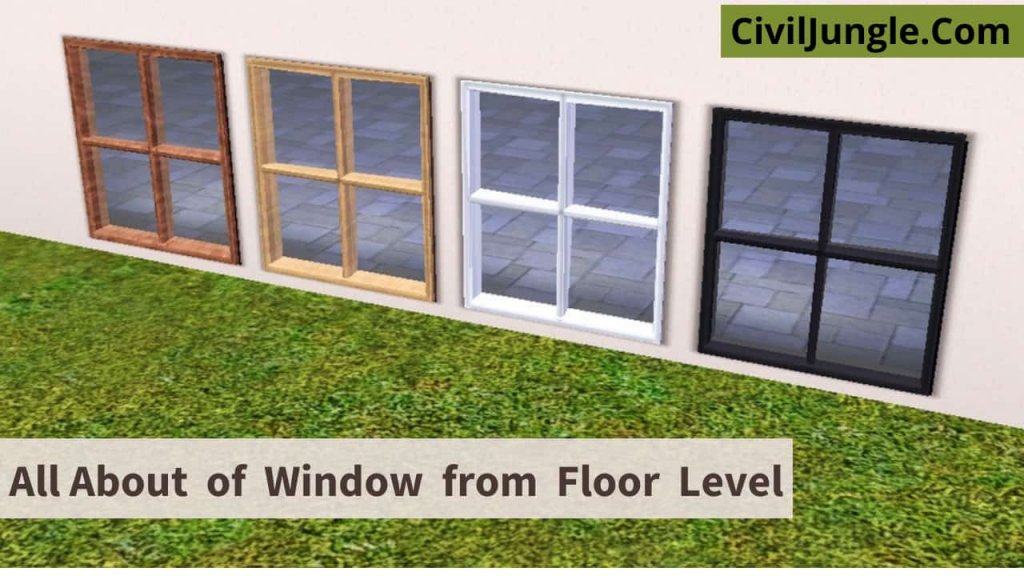
Standard Height of Window from Floor Level
To the base of the window from the floor level up, the height is known as the sill level of the window. It is the bottom or lowermost horizontal part of the window.
According to the constructions from the floor level, the standard height of the windows is generally kept 3 ft. or 900mm.
Following the below calculation, we can be calculated the height of the window from the floor level. The height of the window from the floor level = Height of Door – Height of window.
Window Sill Height from Floor
The height of the window from the ground or floor level is called sill level. Whereas the minimum height required as per standards is 900mm or 3 ft. However, the sill level might vary depending on the requirements of the Houseowner.
Types of Windows
There are have been many types of windows, that’s are below-
- Panel window.
- Single-Hung Window.
- Double-Hung Window.
- Fixed Window.
- Awning Window.
- Casement Window.
- Metal Window.
- Sliding Window.
- Louvered Window.
- Bay Window.
- Gable Window.
- Dormer Window.
- Skylight Window.
- Clear-Storey Window.
1. Panel Window

Panel window consists of a frame that works of horizontal members is called rails, and the vertical members called style, which is grooved of the frame along the inner edges.
2. Single-Hung Window

Single-Hung windows are generally used in offices, modern houses, buildings, and apartments. While the upper one remains fixed, in this type of window, up and down, the lower panel can move.
3. Double-Hung Window

Double-Hung Window is similar to the Single-Hung Window, the difference between two windows are, in the double-hung window we move both lower and upper panel.
4. Fixed Window

In this fixed window, a frame is consisting that shutters are fixed, and the fully glazed shutters are used.
5. Awning Window

In this awning window to the outward side open from the bottom and hinged at the top side. During the light rain its consist ventilation system.
6. Casement Window

In this casement window, a frame is consisting, which is rebated to receive the shutters.
7. Metal Window

The metal windows are widely used in private buildings as well as a various public building, and it is made of mild steel.
8. Sliding Window

Either vertically or horizontally, the sliding windows can move on the roller bearings.
9. Louvered Window

The louvered window is constructed for a ventilation system and does not permit outside vision from the window.
10. Bay Window

From two adjoining sides, in order to obtain ventilation and light, Bay windows are provided.
11. Gable Window

To allow the entry of natural light into the house, the gable window is located at the end of a pitched roof.
12. Dormer Window

On sloping of the roof, the vertical window provided for the lighting and the ventilation is known as the dormer window.
13. Skylight Window

For getting adequate sunlight in the house, the skylight window is provided on a sloping roof. The skylight window is a modern type of window, and nowadays, it is widely used in construction.
14. Clear-Storey Window

The clear-story windows are constructed, where the surrounding rooms have greater ceiling height. The clear-story windows are constructed near the top of the main roof.
Standard Size of Window
Nowadays some standard size of windows for the building are adopted, that’s provided below in feet-
For the residential building, the standard of windows is below-
- 2’0″ X 3’0″
- 3’0″ X 4’0″
- 4’0″ X 5’0″
- 5’0″ X 6’0″
For the kitchen, the standard size of windows is below-
- 3’0″ X 3’6″
- 3’6″ X 3’6″
- 4’0″ X 3’6″
For the bathroom, the standard size of windows is below-
- 2’0″ X 2’0″
- 2’6″ X 2’0″
There has a method for deciding the size of the window-
Considering the breadth of window = 1/8 (width of room + height of a room)
Standard Height of Window from Floor
- To the base of the window from the floor level up, the height is known as the sill level of the window.
- It is the bottom or lowermost horizontal part of the window.
- According to the constructions from the floor level, the standard height of the windows is generally kept 3 ft. or 900mm.
- Following the below calculation, we can be calculated the height of the window from the floor level.
- The height of the window from the floor level = Height of Door – Height of window.
Uses of Windows
There have many uses of the window that is below-
- The common use of window is; it should be provided of a building for entering the sun lighting into the house.
- For the good ventilation system to the house, the windows are used.
- The use of the window provides a house a good air circulation system to the building.
- For providing artificial beauty to a house, various types of windows are used.
- The window is providing an outlook for the residence.
Advantages of Windows

There have many advantages of providing a window for the house-
- The general advantage of the window is; it should be provided of a building for entering the sun lighting into the house.
- Another advantage of windows is, for the good ventilation system to the house the windows are used.
- For providing a good air circulation system to the building, the windows are constructed. This is another advantage of the window.
- The advantage of windows is; it provides an artificial beauty of a house by use with various types of windows.
- The window is providing an outlook for the residence, and it is another advantage of the window.
Disadvantages of Windows

There have many disadvantages of providing a window for the house-
- After providing a window of a house, there has increased the chance of robbery. It is the disadvantage of providing a window.
- Another disadvantage of providing a window of a house is its increase the construction cost of the house.
- If a building many windows are provided, then the strength of the building has been reduced.
- Another disadvantage of windows is, for setting, an expert windows worker is needed.
Applications of Windows
There have many applications of providing a window for the house, that’s are below-
- The common application of window is; it should be provided of a building for entering the sun lighting into the house.
- Another application of windows is, for the good ventilation system to the house the windows are used.
- For providing a good air circulation system to the building, the windows are constructed. This is another application of window.
- The application of windows is; it provides an artificial beauty of a house by use with various types of windows.
- The window is applying for providing an outlook for the residence of the house.
FAQs
What Is the Standard Height of a Window from the Floor Level?
The standard height of a window from the floor level is generally kept at 3 feet (900 mm). This is also known as the sill level of the window.
How Can I Calculate the Height of a Window from the Floor Level?
To calculate the height of the window from the floor level, use the formula: Height of the window from the floor level = Height of Door – Height of Window.
What Are the Different Types of Windows Available?
There are several types of windows, including:
- Panel Window
- Single-Hung Window
- Double-Hung Window
- Fixed Window
- Awning Window
- Casement Window
- Metal Window
- Sliding Window
- Louvered Window
- Bay Window
- Gable Window
- Dormer Window
- Skylight Window
- Clear-Storey Window
What Are the Standard Window Sizes for Residential Buildings?
Common standard sizes for residential windows include:
- 2’0″ X 3’0″
- 3’0″ X 4’0″
- 4’0″ X 5’0″
- 5’0″ X 6’0″
What Sizes Are Typically Used for Kitchen Windows?
Standard sizes for kitchen windows are:
- 3’0″ X 3’6″
- 3’6″ X 3’6″
- 4’0″ X 3’6″
What Sizes Are Standard for Bathroom Windows?
Standard sizes for bathroom windows are:
- 2’0″ X 2’0″
- 2’6″ X 2’0″
What Are the Main Uses of Windows in a Building?
Windows are primarily used for:
- Allowing natural light into the house
- Providing ventilation and air circulation
- Enhancing the aesthetic appeal of the building
- Offering an external view from the residence
What Are the Advantages of Having Windows in a House?
Advantages include:
- Improved natural lighting
- Enhanced ventilation
- Better air circulation
- Increased aesthetic value
- Better external visibility
What Are Some Disadvantages of Having Windows?
Disadvantages may include:
- Increased risk of burglary
- Higher construction costs
- Potential reduction in building strength if too many windows are installed
- The need for skilled labor for installation
How Can I Choose the Right Type and Size of Window for My Home?
Consider the following factors:
- Purpose of the window (ventilation, lighting, aesthetics)
- Room size and location
- Building design and architectural style
- Local climate and weather conditions

